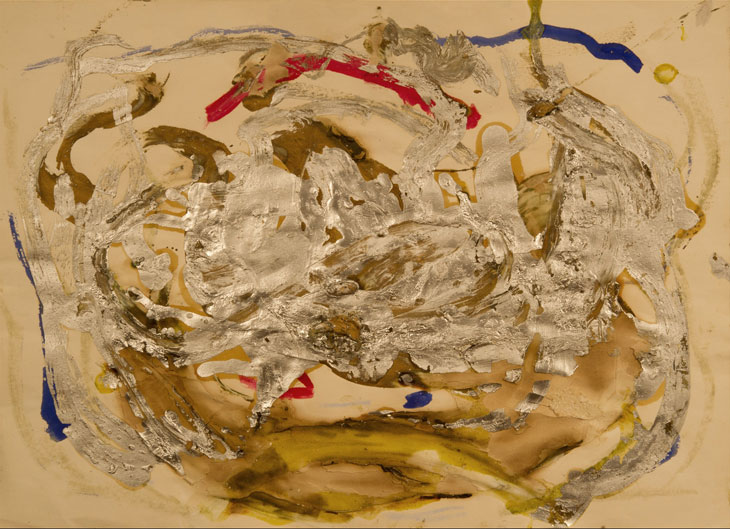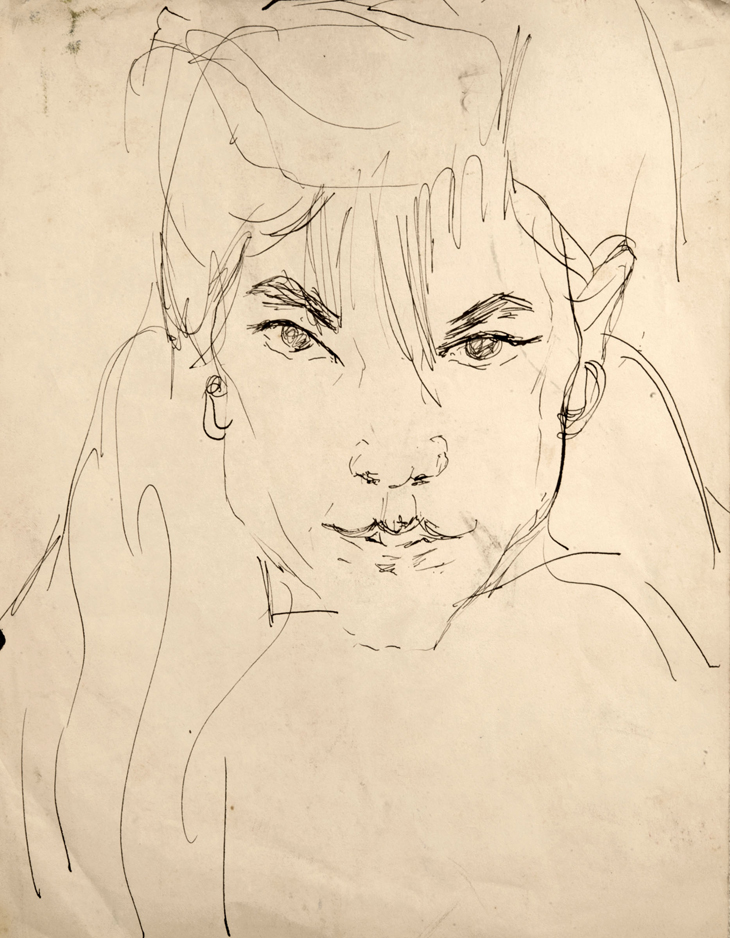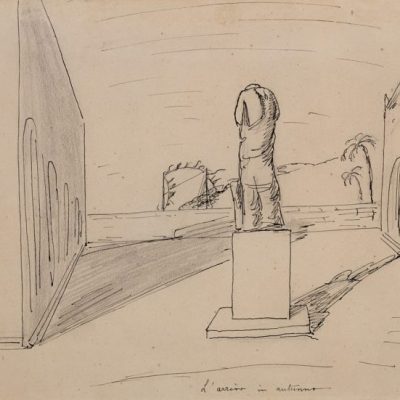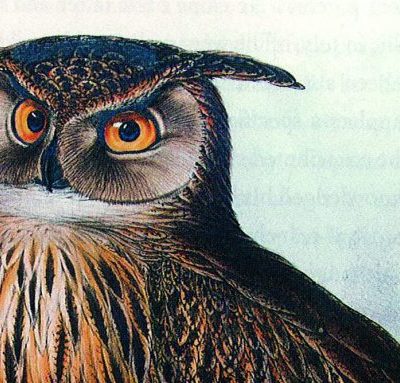‘I only paint beautiful things,’ Jack Kerouac declared in 1956. ‘I use house paint mixed with glue, I use brush and fingertips. In a few years I can be [a] topflight painter if I want. Maybe then I can sell paintings and buy a piano and compose music too – for life is a bore.’ October in Mexico City was clearly getting the writer down. Art was his refuge, his means of expression when words seemed impossible. By 27 January 1959, the pioneer of the Beat Generation had established his own set of artistic rules – rules which are printed in large bold text on one wall of an exhibition of Kerouac’s visual art, at the Museo Maga in Gallarate, a small Italian town just outside Milan:
1) ONLY USE BRUSH, no knife to mash and spread and obliterate brush strokes, no fingers to press in lines that aren’t real
2) USE BRUSH SPONTANEOUSLY. i.e. Without drawing, without long pause or delay, without erasing… pile it on
3) FIGURE MEETS BACKGROUND OR VICE VERSA [sic] BY THE BRUSH;
4) PAINT WHAT YOU SEE IN FRONT OF YOU. NO ‘FICTION’
5) STOP WHEN YOU WANT TO ‘IMPROVE’
– IT’S DONE
As his clear formulations suggest, Kerouac was eager to give himself over to what he saw as the impassioned act of painting. On a number of occasions, he told friends that if he hadn’t been a writer he would have been a painter. While his skill as an artist is questionable, the collection of around 80 objects, sketches and paintings brought together at the Museo Maga is illuminating. It’s the details of Kerouac’s life and art that are most striking: the woven cover of a small hip flask; the jagged pencil lines that divide the sketched body of a grieving Madonna; the roving electric blue eyes of his replica painting of Pope John Paul II (Kerouac reportedly loved the way the eyes would follow him). Although many of the artworks themselves – somewhat half-hearted paintings and glorified sketchbook pages – are a little underwhelming, they are thoughtfully contextualised in a way that leaves the viewer with a truly lasting impression of Kerouac’s restless creativity.
Untitled (n.d.), Jack Kerouac.

The exhibition begins with a series of black-and-white portraits of Kerouac, taken in Milan in 1966 by Ettore Sottsass. Here Kerouac appears characteristically aloof, reclining with a cigarette and laughing with Sottsass’s wife, the writer and translator Fernanda Pivano. Also on display is a selection of Kerouac’s belongings: dirty white plimsoles, a patterned shirt, a rolled-up burgundy fabric belt, white-washed denim cut-off shorts, and a faded khaki cap sit side-by-side in a glass cabinet, neatly folded, as if expectantly awaiting the return of their owner.
We are continually reminded of Kerouac’s unique position in the artistic community of his time. In the 1950s and ’60s, he successfully straddled the visual art and literary worlds; among his friends were artists such as Willem de Kooning, Larry Rivers, and Franz Kline. He received fruitcake for Christmas from Stanley Twardowicz, and moved in the same circles as Jackson Pollock. The variety of his techniques – pen and ink, oil on canvas, acrylic on wood, mixed media – make clear that his artistic influences were wide. As well as taking pointers from Abstract Expressionism with his frenzied ‘action paintings’, scraps of paper covered in swirls of paint, an interest in religious art also saw Kerouac frequently revert to figurative presentations and more traditional subjects. In one of his more successful paintings a woman with pale skin lounges naked behind a guitar. The composition, with its vibrant blue and pink flashes, is reminiscent of a Matisse.
Untitled (woman with guitar) (n.d.), Jack Kerouac. © Il Rivellino LDV

Friends aside, Kerouac’s lover at the time, Dody Muller, was also a painter. The world of texture and technicolour surrounded him constantly. ‘He liked to sit in my studio and watch me paint,’ Muller once recalled. ‘He admired, envied, and was awed by the painters.’
Muller’s influence on Kerouac was significant. In fact, it’s a minimal drawing of her that stands out as one of the most moving works in the show. Kerouac has gently etched Muller’s delicate features with a fine line that expresses an intimacy between the couple. It’s a closeness which many of the more elaborate painted portraits – such as a depiction of Cardinale Montini, the future Pope Paul VI, copied multiple times from a photograph found in Time magazine – lack.
Untitled (Dody Muller) (n.d.), Jack Kerouac. © Il Rivellino LDV

There is a childish eagerness to Kerouac’s artistic attempts: the simple lines; the half-finished doodles; the vibrant Pollock-like dribbles of paint. It’s clear from the start of the exhibition that Kerouac’s real power lay with words. The works on display, however, are shown to have served a wider creative purpose. The scrawl of a doodle or the flick of a brush can be understood as mechanisms through which Kerouac’s mind would tick over what it needed to process from the world before spitting it out sentence by sentence on to a page. ‘Painting’s my hobby,’ he once said. ‘I don’t like to do it. It makes my hands dirty.’ We can only be thankful that the unruliness of paint kept this writer busy with words.
‘Kerouac: Beat Painting’ is at the Museo Maga, Gallarate, until 22 April.



